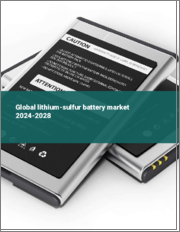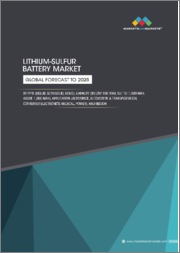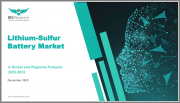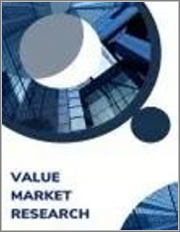
|
시장보고서
상품코드
1344481
자동차용 리튬황 배터리 시장 : 배터리 용량별, 추진방식별, 차량 유형별 - 세계 기회 분석 및 산업 예측(2026-2035년)Automotive Lithium-sulfur Battery Market By Battery Capacity, By Propulsion Type, By Vehicle Type : Global Opportunity Analysis and Industry Forecast, 2026-2035 |
||||||
자동차용 리튬황 배터리 시장은 전기자동차 수요 증가와 전 세계 에너지 밀도 증가로 인해 2026년부터 2035년까지 26.1%의 높은 성장률을 기록할 것으로 예상됩니다.
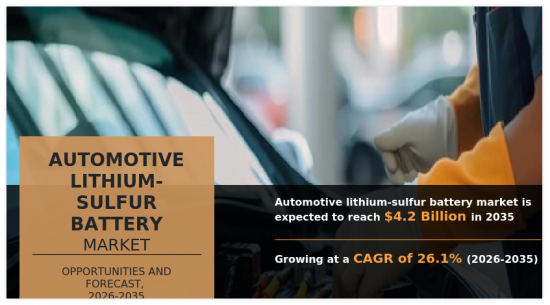
다양한 배터리 제조업체, 자동차 OEM(주문자상표부착생산), 연구기관, 원자재 및 부품 공급업체가 첨단 자동차용 리튬황 배터리 시장 개척을 위해 노력하고 있으며, 이는 시장 수요를 더욱 촉진하는 데 기여하고 있습니다. 예를 들어, 2022년 1월 미시간대학교 연구팀은 재생 케블라를 이용한 차세대 리튬황 배터리를 성공적으로 개발했습니다. 연구팀은 전기자동차(EV)와 같은 상업용 애플리케이션을 위해 반복적으로 충전할 수 있는 생물에서 영감을 얻은 배터리 필름을 만들었습니다.
전기차 수요 증가, 에너지 밀도 향상, 비용 절감 등의 요인이 시장 성장의 원동력이 될 것으로 예상됩니다. 그러나 안전에 대한 우려와 제한된 사이클 수명은 시장 성장을 저해하는 요인으로 작용하고 있습니다. 또한, 정부 기관 및 민간 기업의 투자 증가, 연구 및 기술 발전은 예측 기간 동안 시장 성장에 유리한 기회를 제공 할 것으로 예상되는 요인 중 일부입니다.
목차
제1장 서론
제2장 주요 요약
제3장 시장 개요
- 시장 정의와 범위
- 주요 조사 결과
- 영향요인
- 주요 투자 기회
- Porter's Five Forces 분석
- 시장 역학
- 성장 촉진요인
- 전기자동차 수요 성장
- 에너지 밀도 향상
- 비용 절감
- 성장 억제요인
- 안전성에 대한 우려
- 주기 수명 제한
- 기회
- 정부 단체나 민간 기업 투자 증가
- 조사와 기술 진보
- 성장 촉진요인
- COVID-19의 시장에 대한 영향 분석
제4장 자동차용 리튬황 배터리 시장 : 배터리 용량별
- 개요
- 500mAh 미만
- 501- 1000mAh 미만
- 1000 mAh 이상
제5장 자동차용 리튬황 배터리 시장 : 추진 유형별
- 개요
- 배터리 전기자동차
- 하이브리드 전기자동차
- 플러그인 하이브리드 전기자동차
제6장 자동차용 리튬황 배터리 시장 : 차종별
- 개요
- 이륜차
- 승용차
- 상용차
제7장 자동차용 리튬황 배터리 시장 : 지역별
- 개요
- 북미
- 미국
- 캐나다
- 멕시코
- 유럽
- 영국
- 독일
- 네덜란드
- 노르웨이
- 기타 유럽
- 아시아태평양
- 중국
- 일본
- 인도
- 한국
- 기타 아시아태평양
- 라틴아메리카
- 라틴아메리카
- 중동
- 아프리카
제8장 경쟁 상황
- 서론
- 주요 성공 전략
- 주요 10개사 제품 매핑
- 경쟁 대시보드
- 경쟁 히트맵
- 주요 기업의 포지셔닝, 2025년
제9장 기업 개요
- Giner Inc.
- Ilika
- Johnson Matthey
- LG Chem
- Lyten, Inc.
- Morrow Batteries
- NexTech Batteries
- PPBC and its licensees
- Sion Power Corporation
- WAE Technologies Limited
The automotive lithium-sulfur battery market is expected to experience a significant growth rate of 26.1% from 2026 to 2035 owing to growth in demand for electric vehicles, increased energy density across the globe - Allied Market Research

Various battery manufacturers, automotive OEMs (original equipment manufacturers), research institutions, and suppliers of raw materials and components are working on development of advanced automotive lithium-sulfur battery to further help in driving demand for the market. For instance, in January 2022, a team of researchers at the University of Michigan successfully developed a next-generation lithium-sulfur battery by incorporating recycled Kevlar. They have created a bio-inspired battery membrane, which allows the batteries to be charged repeatedly for commercial applications, including electric vehicles (EVs).
Factors, such as growth in demand for electric vehicles, increased energy density, and cost reduction, are anticipated to drive the market growth. However, safety concerns and limited cycle life hinder the market growth. Further, increase in investment of government association and private enterprises and research and technological advancements are some of the factors that are expected to offer lucrative opportunities for the market growth during the forecast period.
The market is segmented on the basis of battery capacity, propulsion type, vehicle type, and region. By battery capacity, it is categorized into less than 500mAh, between 501 to 1000 mAh, and more than 1000 mAh. By propulsion type, it is categorized into battery electric vehicle, hybrid electric vehicle, and plug-in hybrid electric vehicles. By vehicle type, it is categorized into two-wheeler, passenger vehicle, and commercial vehicle. Region-wise, it is analysed across North America, Europe, Asia-Pacific, and LAMEA.
The major companies profiled in the automotive lithium battery market include Giner, Inc., Ilika, Johnson Matthey, LG Chem, Lyten Inc., Morrow Batteries, NexTech Batteries, PPBC and its licensees, Sion Power Corporation, and Williams Advanced Limited.
Key Benefits For Stakeholders
- This report provides a quantitative analysis of the market segments, current trends, estimations, and dynamics of the automotive lithium-sulfur battery market analysis from 2025 to 2035 to identify the prevailing automotive lithium-sulfur battery market opportunities.
- The market research is offered along with information related to key drivers, restraints, and opportunities.
- Porter's five forces analysis highlights the potency of buyers and suppliers to enable stakeholders make profit-oriented business decisions and strengthen their supplier-buyer network.
- In-depth analysis of the automotive lithium-sulfur battery market segmentation assists to determine the prevailing market opportunities.
- Major countries in each region are mapped according to their revenue contribution to the global market.
- Market player positioning facilitates benchmarking and provides a clear understanding of the present position of the market players.
- The report includes the analysis of the regional as well as global automotive lithium-sulfur battery market trends, key players, market segments, application areas, and market growth strategies.
Key Market Segments
By Battery Capacity
- Less than 500mAh
- Between 501 to 1000 mAh
- More than 1000 mAh
By Propulsion Type
- Battery Electric Vehicle
- Hybrid Electric Vehicle
- Plug-in hybrid Electric Vehicles
By Vehicle Type
- Two-wheeler
- Passenger Vehicle
- Commercial Vehicle
By Region
- North America
- U.S.
- Canada
- Mexico
- Europe
- UK
- Germany
- Netherlands
- Norway
- Rest of Europe
- Asia-Pacific
- China
- Japan
- India
- South Korea
- Rest of Asia-Pacific
- LAMEA
- Latin America
- Middle East
- Africa
Key Market Players:
- Giner Inc.
- Ilika
- Johnson Matthey
- LG Chem
- Lyten, Inc.
- Morrow Batteries
- NexTech Batteries
- PPBC and its licensees
- Sion Power Corporation
- WAE Technologies Limited
TABLE OF CONTENTS
CHAPTER 1: INTRODUCTION
- 1.1. Report description
- 1.2. Key market segments
- 1.3. Key benefits to the stakeholders
- 1.4. Research Methodology
- 1.4.1. Primary research
- 1.4.2. Secondary research
- 1.4.3. Analyst tools and models
CHAPTER 2: EXECUTIVE SUMMARY
- 2.1. CXO Perspective
CHAPTER 3: MARKET OVERVIEW
- 3.1. Market definition and scope
- 3.2. Key findings
- 3.2.1. Top impacting factors
- 3.2.2. Top investment pockets
- 3.3. Porter's five forces analysis
- 3.3.1. Low-moderate bargaining power of suppliers
- 3.3.2. Moderate-high threat of new entrants
- 3.3.3. Low-moderate threat of substitutes
- 3.3.4. Moderate-high intensity of rivalry
- 3.3.5. Moderate bargaining power of buyers
- 3.4. Market dynamics
- 3.4.1. Drivers
- 3.4.1.1. Growth in demand for electric vehicle
- 3.4.1.2. Increased energy density
- 3.4.1.3. Cost reduction
- 3.4.1. Drivers
- 3.4.2. Restraints
- 3.4.2.1. Safety concerns
- 3.4.2.2. Limited cycle life
- 3.4.3. Opportunities
- 3.4.3.1. Increase in investment of government association and private enterprises
- 3.4.3.2. Research and technological advancements
- 3.5. COVID-19 Impact Analysis on the market
CHAPTER 4: AUTOMOTIVE LITHIUM-SULFUR BATTERY MARKET, BY BATTERY CAPACITY
- 4.1. Overview
- 4.1.1. Market size and forecast
- 4.2. Less than 500mAh
- 4.2.1. Key market trends, growth factors and opportunities
- 4.2.2. Market size and forecast, by region
- 4.2.3. Market share analysis by country
- 4.3. Between 501 to 1000 mAh
- 4.3.1. Key market trends, growth factors and opportunities
- 4.3.2. Market size and forecast, by region
- 4.3.3. Market share analysis by country
- 4.4. More than 1000 mAh
- 4.4.1. Key market trends, growth factors and opportunities
- 4.4.2. Market size and forecast, by region
- 4.4.3. Market share analysis by country
CHAPTER 5: AUTOMOTIVE LITHIUM-SULFUR BATTERY MARKET, BY PROPULSION TYPE
- 5.1. Overview
- 5.1.1. Market size and forecast
- 5.2. Battery Electric Vehicle
- 5.2.1. Key market trends, growth factors and opportunities
- 5.2.2. Market size and forecast, by region
- 5.2.3. Market share analysis by country
- 5.3. Hybrid Electric Vehicle
- 5.3.1. Key market trends, growth factors and opportunities
- 5.3.2. Market size and forecast, by region
- 5.3.3. Market share analysis by country
- 5.4. Plug-in hybrid Electric Vehicles
- 5.4.1. Key market trends, growth factors and opportunities
- 5.4.2. Market size and forecast, by region
- 5.4.3. Market share analysis by country
CHAPTER 6: AUTOMOTIVE LITHIUM-SULFUR BATTERY MARKET, BY VEHICLE TYPE
- 6.1. Overview
- 6.1.1. Market size and forecast
- 6.2. Two-wheeler
- 6.2.1. Key market trends, growth factors and opportunities
- 6.2.2. Market size and forecast, by region
- 6.2.3. Market share analysis by country
- 6.3. Passenger Vehicle
- 6.3.1. Key market trends, growth factors and opportunities
- 6.3.2. Market size and forecast, by region
- 6.3.3. Market share analysis by country
- 6.4. Commercial Vehicle
- 6.4.1. Key market trends, growth factors and opportunities
- 6.4.2. Market size and forecast, by region
- 6.4.3. Market share analysis by country
CHAPTER 7: AUTOMOTIVE LITHIUM-SULFUR BATTERY MARKET, BY REGION
- 7.1. Overview
- 7.1.1. Market size and forecast By Region
- 7.2. North America
- 7.2.1. Key trends and opportunities
- 7.2.2. Market size and forecast, by Battery Capacity
- 7.2.3. Market size and forecast, by Propulsion Type
- 7.2.4. Market size and forecast, by Vehicle Type
- 7.2.5. Market size and forecast, by country
- 7.2.5.1. U.S.
- 7.2.5.1.1. Key market trends, growth factors and opportunities
- 7.2.5.1.2. Market size and forecast, by Battery Capacity
- 7.2.5.1.3. Market size and forecast, by Propulsion Type
- 7.2.5.1.4. Market size and forecast, by Vehicle Type
- 7.2.5.2. Canada
- 7.2.5.2.1. Key market trends, growth factors and opportunities
- 7.2.5.2.2. Market size and forecast, by Battery Capacity
- 7.2.5.2.3. Market size and forecast, by Propulsion Type
- 7.2.5.2.4. Market size and forecast, by Vehicle Type
- 7.2.5.3. Mexico
- 7.2.5.3.1. Key market trends, growth factors and opportunities
- 7.2.5.3.2. Market size and forecast, by Battery Capacity
- 7.2.5.3.3. Market size and forecast, by Propulsion Type
- 7.2.5.3.4. Market size and forecast, by Vehicle Type
- 7.3. Europe
- 7.3.1. Key trends and opportunities
- 7.3.2. Market size and forecast, by Battery Capacity
- 7.3.3. Market size and forecast, by Propulsion Type
- 7.3.4. Market size and forecast, by Vehicle Type
- 7.3.5. Market size and forecast, by country
- 7.3.5.1. UK
- 7.3.5.1.1. Key market trends, growth factors and opportunities
- 7.3.5.1.2. Market size and forecast, by Battery Capacity
- 7.3.5.1.3. Market size and forecast, by Propulsion Type
- 7.3.5.1.4. Market size and forecast, by Vehicle Type
- 7.3.5.2. Germany
- 7.3.5.2.1. Key market trends, growth factors and opportunities
- 7.3.5.2.2. Market size and forecast, by Battery Capacity
- 7.3.5.2.3. Market size and forecast, by Propulsion Type
- 7.3.5.2.4. Market size and forecast, by Vehicle Type
- 7.3.5.3. Netherlands
- 7.3.5.3.1. Key market trends, growth factors and opportunities
- 7.3.5.3.2. Market size and forecast, by Battery Capacity
- 7.3.5.3.3. Market size and forecast, by Propulsion Type
- 7.3.5.3.4. Market size and forecast, by Vehicle Type
- 7.3.5.4. Norway
- 7.3.5.4.1. Key market trends, growth factors and opportunities
- 7.3.5.4.2. Market size and forecast, by Battery Capacity
- 7.3.5.4.3. Market size and forecast, by Propulsion Type
- 7.3.5.4.4. Market size and forecast, by Vehicle Type
- 7.3.5.5. Rest of Europe
- 7.3.5.5.1. Key market trends, growth factors and opportunities
- 7.3.5.5.2. Market size and forecast, by Battery Capacity
- 7.3.5.5.3. Market size and forecast, by Propulsion Type
- 7.3.5.5.4. Market size and forecast, by Vehicle Type
- 7.4. Asia-Pacific
- 7.4.1. Key trends and opportunities
- 7.4.2. Market size and forecast, by Battery Capacity
- 7.4.3. Market size and forecast, by Propulsion Type
- 7.4.4. Market size and forecast, by Vehicle Type
- 7.4.5. Market size and forecast, by country
- 7.4.5.1. China
- 7.4.5.1.1. Key market trends, growth factors and opportunities
- 7.4.5.1.2. Market size and forecast, by Battery Capacity
- 7.4.5.1.3. Market size and forecast, by Propulsion Type
- 7.4.5.1.4. Market size and forecast, by Vehicle Type
- 7.4.5.2. Japan
- 7.4.5.2.1. Key market trends, growth factors and opportunities
- 7.4.5.2.2. Market size and forecast, by Battery Capacity
- 7.4.5.2.3. Market size and forecast, by Propulsion Type
- 7.4.5.2.4. Market size and forecast, by Vehicle Type
- 7.4.5.3. India
- 7.4.5.3.1. Key market trends, growth factors and opportunities
- 7.4.5.3.2. Market size and forecast, by Battery Capacity
- 7.4.5.3.3. Market size and forecast, by Propulsion Type
- 7.4.5.3.4. Market size and forecast, by Vehicle Type
- 7.4.5.4. South Korea
- 7.4.5.4.1. Key market trends, growth factors and opportunities
- 7.4.5.4.2. Market size and forecast, by Battery Capacity
- 7.4.5.4.3. Market size and forecast, by Propulsion Type
- 7.4.5.4.4. Market size and forecast, by Vehicle Type
- 7.4.5.5. Rest of Asia-Pacific
- 7.4.5.5.1. Key market trends, growth factors and opportunities
- 7.4.5.5.2. Market size and forecast, by Battery Capacity
- 7.4.5.5.3. Market size and forecast, by Propulsion Type
- 7.4.5.5.4. Market size and forecast, by Vehicle Type
- 7.5. LAMEA
- 7.5.1. Key trends and opportunities
- 7.5.2. Market size and forecast, by Battery Capacity
- 7.5.3. Market size and forecast, by Propulsion Type
- 7.5.4. Market size and forecast, by Vehicle Type
- 7.5.5. Market size and forecast, by country
- 7.5.5.1. Latin America
- 7.5.5.1.1. Key market trends, growth factors and opportunities
- 7.5.5.1.2. Market size and forecast, by Battery Capacity
- 7.5.5.1.3. Market size and forecast, by Propulsion Type
- 7.5.5.1.4. Market size and forecast, by Vehicle Type
- 7.5.5.2. Middle East
- 7.5.5.2.1. Key market trends, growth factors and opportunities
- 7.5.5.2.2. Market size and forecast, by Battery Capacity
- 7.5.5.2.3. Market size and forecast, by Propulsion Type
- 7.5.5.2.4. Market size and forecast, by Vehicle Type
- 7.5.5.3. Africa
- 7.5.5.3.1. Key market trends, growth factors and opportunities
- 7.5.5.3.2. Market size and forecast, by Battery Capacity
- 7.5.5.3.3. Market size and forecast, by Propulsion Type
- 7.5.5.3.4. Market size and forecast, by Vehicle Type
CHAPTER 8: COMPETITIVE LANDSCAPE
- 8.1. Introduction
- 8.2. Top winning strategies
- 8.3. Product Mapping of Top 10 Player
- 8.4. Competitive Dashboard
- 8.5. Competitive Heatmap
- 8.6. Top player positioning, 2025
CHAPTER 9: COMPANY PROFILES
- 9.1. Giner Inc.
- 9.1.1. Company overview
- 9.1.2. Key Executives
- 9.1.3. Company snapshot
- 9.1.4. Operating business segments
- 9.1.5. Product portfolio
- 9.2. Ilika
- 9.2.1. Company overview
- 9.2.2. Key Executives
- 9.2.3. Company snapshot
- 9.2.4. Operating business segments
- 9.2.5. Product portfolio
- 9.2.6. Business performance
- 9.3. Johnson Matthey
- 9.3.1. Company overview
- 9.3.2. Key Executives
- 9.3.3. Company snapshot
- 9.3.4. Operating business segments
- 9.3.5. Product portfolio
- 9.3.6. Business performance
- 9.3.7. Key strategic moves and developments
- 9.4. LG Chem
- 9.4.1. Company overview
- 9.4.2. Key Executives
- 9.4.3. Company snapshot
- 9.4.4. Operating business segments
- 9.4.5. Product portfolio
- 9.4.6. Business performance
- 9.4.7. Key strategic moves and developments
- 9.5. Lyten, Inc.
- 9.5.1. Company overview
- 9.5.2. Key Executives
- 9.5.3. Company snapshot
- 9.5.4. Operating business segments
- 9.5.5. Product portfolio
- 9.5.6. Key strategic moves and developments
- 9.6. Morrow Batteries
- 9.6.1. Company overview
- 9.6.2. Key Executives
- 9.6.3. Company snapshot
- 9.6.4. Operating business segments
- 9.6.5. Product portfolio
- 9.6.6. Key strategic moves and developments
- 9.7. NexTech Batteries
- 9.7.1. Company overview
- 9.7.2. Key Executives
- 9.7.3. Company snapshot
- 9.7.4. Operating business segments
- 9.7.5. Product portfolio
- 9.7.6. Key strategic moves and developments
- 9.8. PPBC and its licensees
- 9.8.1. Company overview
- 9.8.2. Key Executives
- 9.8.3. Company snapshot
- 9.8.4. Operating business segments
- 9.8.5. Product portfolio
- 9.9. Sion Power Corporation
- 9.9.1. Company overview
- 9.9.2. Key Executives
- 9.9.3. Company snapshot
- 9.9.4. Operating business segments
- 9.9.5. Product portfolio
- 9.10. WAE Technologies Limited
- 9.10.1. Company overview
- 9.10.2. Key Executives
- 9.10.3. Company snapshot
- 9.10.4. Operating business segments
- 9.10.5. Product portfolio











